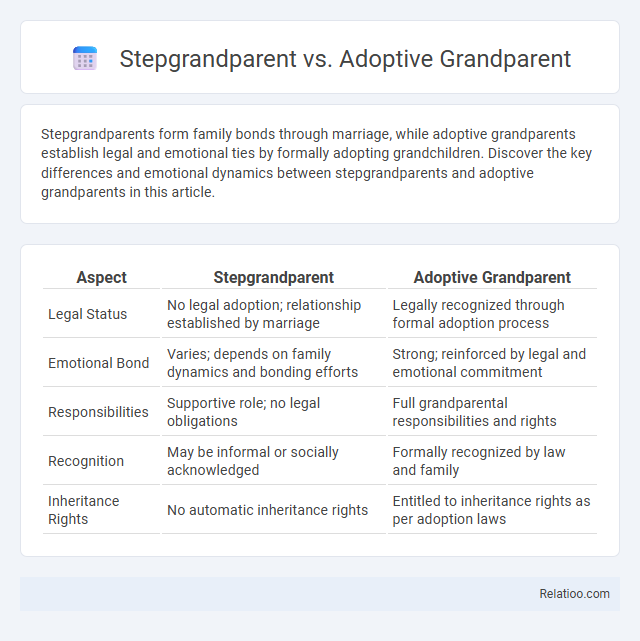Stepgrandparents form family bonds through marriage, while adoptive grandparents establish legal and emotional ties by formally adopting grandchildren. Discover the key differences and emotional dynamics between stepgrandparents and adoptive grandparents in this article.
Table of Comparison
| Aspect | Stepgrandparent | Adoptive Grandparent |
|---|---|---|
| Legal Status | No legal adoption; relationship established by marriage | Legally recognized through formal adoption process |
| Emotional Bond | Varies; depends on family dynamics and bonding efforts | Strong; reinforced by legal and emotional commitment |
| Responsibilities | Supportive role; no legal obligations | Full grandparental responsibilities and rights |
| Recognition | May be informal or socially acknowledged | Formally recognized by law and family |
| Inheritance Rights | No automatic inheritance rights | Entitled to inheritance rights as per adoption laws |
Definition of Stepgrandparent and Adoptive Grandparent
A stepgrandparent is the spouse of a biological grandparent who gains a familial role through marriage rather than blood relation, often forming bonds through blended families. An adoptive grandparent is an individual who assumes grandparental responsibilities and legal recognition by adopting a grandchild or being formally recognized as a grandparent through legal processes. Both roles differ from biological grandparents in terms of genetic ties but can hold significant emotional and social influence in a grandchild's life.
Legal Relationships and Rights
Stepgrandparents typically have no automatic legal rights or obligations toward stepgrandchildren unless formalized through adoption or guardianship. Adoptive grandparents gain legal recognition and rights akin to biological grandparents once the adoption process is completed, including visitation rights and inheritance claims. Legal relationships for stepgrandparents can sometimes be established through court orders or family agreements, but these are less common and vary by jurisdiction.
Emotional Bonds and Family Dynamics
Emotional bonds between stepgrandparents and grandchildren often develop gradually, influenced by the quality of interactions and family acceptance, whereas adoptive grandparents typically experience a deep, immediate connection rooted in legal and emotional commitment. Family dynamics can become complex as stepgrandparents navigate roles that vary by previous marital ties and blended family structures, while adoptive grandparents' roles are more defined through formal adoption processes. Both relationships require intentional efforts to foster trust, love, and stability within evolving family systems.
Roles and Responsibilities in the Child’s Life
Stepgrandparents, adoptive grandparents, and biological grandparents each play unique roles in a child's life based on legal, emotional, and familial dynamics. Stepgrandparents often provide support and guidance derived from blended family relationships without the legal obligations that adoptive grandparents assume through formal adoption processes. Adoptive grandparents hold legal and emotional responsibilities similar to biological grandparents, including caregiving, decision-making, and inheritance considerations, while stepgrandparents' roles depend largely on family acceptance and personal involvement.
Inheritance and Financial Considerations
Stepgrandparents, adoptive grandparents, and biological grandparents each have distinct roles in inheritance and financial considerations. Your rights and entitlements vary significantly based on legal recognition; adoptive grandparents often have clearer inheritance rights through formal adoption, while stepgrandparents' claims typically depend on wills or trusts. Understanding these differences is crucial for estate planning to ensure your financial legacy is distributed according to your wishes.
Cultural Perceptions and Societal Acceptance
Cultural perceptions of stepgrandparents often vary, with some societies recognizing them as integral family members while others maintain a preference for biological or adoptive grandparents. Adoptive grandparents generally experience broader societal acceptance due to legal ties established through adoption, which often confer similar familial status and responsibilities as biological grandparents. Stepgrandparents may face challenges in societal acceptance depending on cultural norms that emphasize blood relations, yet evolving family dynamics and increased blended families contribute to growing recognition of their role.
Challenges Faced by Stepgrandparents
Stepgrandparents often face unique challenges such as establishing trust and emotional bonds with stepgrandchildren while navigating complex family dynamics. Unlike adoptive grandparents who have legal ties, stepgrandparents must build relationships without formal recognition, which can lead to feelings of exclusion or ambiguity in their role. You may find that clear communication and patience are essential in overcoming these obstacles and fostering meaningful connections within blended families.
Unique Experiences of Adoptive Grandparents
Adoptive grandparents often navigate unique emotional dynamics as they build bonds with grandchildren through legal and emotional commitment rather than biological ties, fostering deep connections rooted in choice and family resilience. Unlike stepgrandparents or step-grandparents, whose relationships may hinge on the blending of families through remarriage, adoptive grandparents experience the profound joy and challenges of acceptance and integration from the outset. Their role emphasizes nurturing identity, heritage, and unconditional support, making their experiences distinct in the spectrum of grandparental relationships.
Navigating Boundaries and Expectations
Navigating boundaries and expectations between stepgrandparents, adoptive grandparents, and biological grandparents requires clear communication and mutual respect to foster healthy family relationships. Stepgrandparents often balance their role by recognizing the existing family dynamics while offering support without overstepping, whereas adoptive grandparents embrace legal and emotional ties, emphasizing inclusion and acceptance. Establishing consistent boundaries and understanding each grandparent's role helps minimize conflicts and strengthens intergenerational bonds.
Supporting Healthy Relationships for Children
Supporting healthy relationships for children involves understanding the unique roles of stepgrandparents, adoptive grandparents, and biological grandparents. Stepgrandparents often build bonds through new family dynamics, while adoptive grandparents provide continuity and emotional security rooted in legal and emotional ties. Your encouragement and inclusive approach can foster trust and a sense of belonging, crucial for the child's emotional well-being.

Infographic: Stepgrandparent vs Adoptive Grandparent
 relatioo.com
relatioo.com